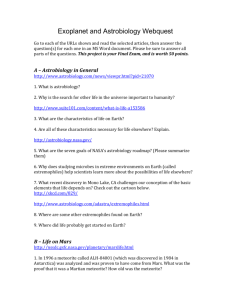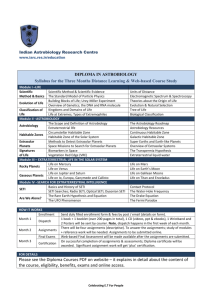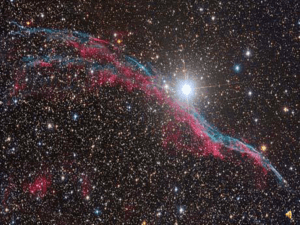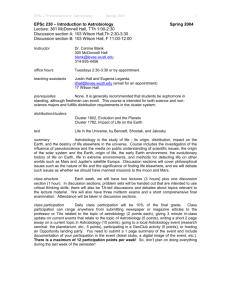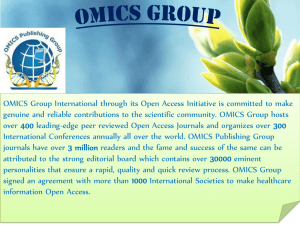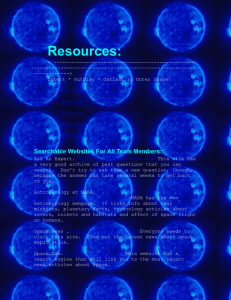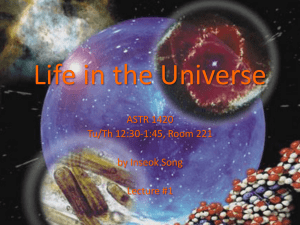astrobiology in 1 hour
advertisement
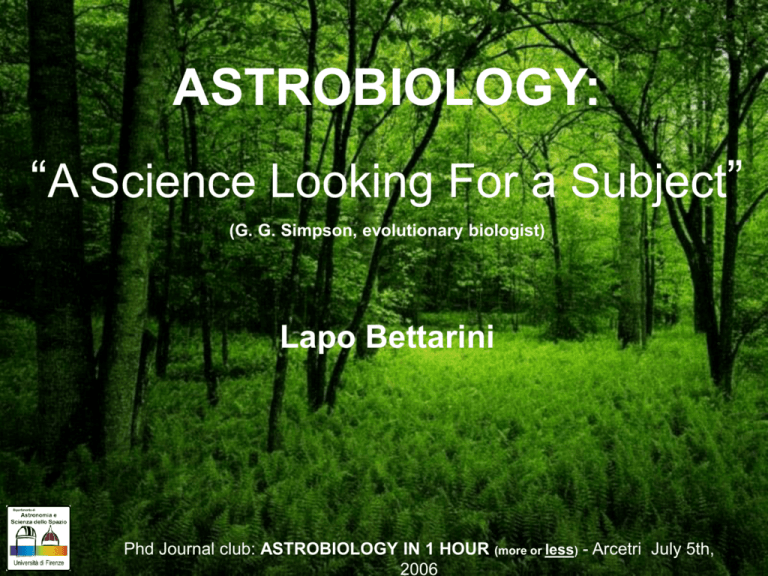
ASTROBIOLOGY: “A Science Looking For a Subject” (G. G. Simpson, evolutionary biologist) Lapo Bettarini Phd Journal club: ASTROBIOLOGY IN 1 HOUR (more or less) - Arcetri July 5th, 2006 OUTLINE Just a bit of hystory Rough guide to Astrobiology The origin (and the meaning) of Life: “Long term” goals “Short term” goals What’s up with astrobiology today… A last question… Phd Journal club: ASTROBIOLOGY IN 1 HOUR (more or less) - Arcetri July 5th, 2006 …JUST A BIT OF HISTORY - 1 1941: L. J. Lafleur, “Astrobiology”, leaflet 143, Astronomical Society of the Pacific “Astrobiology: the consideration of life in the Universe elsewhere than in the earth” 1949: G.A. Tikhov, ”Astrobotany”, Kazakhstan SSR Acad. Of Science Press, Alma Ata, Kazakhstan (in russian) 1953: G.A. Tikhov, “Astrobiology”, Molodaya Gvardia Press, Moscow (in russian) 1953: H. Struhold, “The green and the red planet: a physiological study of the possibility of life on Mars”, Univ. of New Mexico Press, Albuquerque 1956: F.A. Pereira, “Introducao a Interplanetaria Brasilera, Sao Paulo, Brazil Astrobiologia”, Sociedade Phd Journal club: ASTROBIOLOGY IN 1 HOUR (more or less) - Arcetri July 5th, 2006 Biogenic-looking features in ALH84001 Martian meteorite. Image credit: NASA …JUST A BIT OF HISTORY - 2 1975-6: first 3 biological experiments on Mars made by means of Viking 1 and Viking 2…inconclusive… 1996: liquid water interior of Europa (Galielo Orbiter) 1996: INDICATORS OF PRIOR LIFE ON MARS 1996: first astrobiology scientific conference 1998: NASA Astrobiology Institute and the Nasa Astrobiology Roadmap Phd Journal club: ASTROBIOLOGY IN 1 HOUR (more or less) - Arcetri July 5th, 2006 THE STUDY OF THE LIVING UNIVERSE (NAI 2004) How does LIFE begin and evolve? Does LIFE exist elsewhere in the universe? What is the future of LIFE on Earth and beyond? Phd Journal club: ASTROBIOLOGY IN 1 HOUR (more or less) - Arcetri July 5th, 2006 SO, FIRST OF ALL…WHAT’S LIFE ? No generally accepted definitions (robust counterexamples): List of failed attempts (C. Sagan 1970) METABOLIC definitions imply the growth and the reproduction through chemical reactions….for example…FIRE!!!! THERMODYNAMIC definitions imply the creation and the support of a local order…for example…CRYSTALS!!!! (that may also reproduce) LEONARDO DA VINCI’s DILEMMA: What’s WATER? We need a theory of the NATURE of the living systems Phd Journal club: ASTROBIOLOGY IN 1 HOUR (more or less) - Arcetri July 5th, 2006 Step 1: what we (should) know, life on earth Water Suite of so-called “biogienic” elements (carbon) Usable source of energy (light and/or chemical energy) Step 2: what we (would like to) know, “other” lifes Other polar solvents (liquid ammonia, Barrow & Tipler 1986) or non-polar solvent (methane or ethane, Lunine, Stevenson & Young 1983) Silicon-based chemistry (Feinberg & Shapiro 1980) EM fields, gravity, kinetic energy… (Schulze-Makuch & Irwin 1984) Phd Journal club: ASTROBIOLOGY IN 1 HOUR (more or less) - Arcetri July 5th, 2006 Step 3: definition of an habitable universe HZ: Solar (and Stellar) Habitable Zone (Kasting & Catling 2003) GHZ: Galactic Habitable Zone (Gonzalez, Brownlee & ward 2001) Step 4: three ways to search for extraterrestrial life In situ (and ultimately, sample return) searches within the solar system The spectral examination of solar and extrasolar planetary atmospheres for chemical evidences of life Searches for evidence of extraterrestrial technology Phd Journal club: ASTROBIOLOGY IN 1 HOUR (more or less) - Arcetri July 5th, 2006 A stabilizing feed back driven by plate tectonics on Earth has allowed CO2 and H20 on Earth to maintain greenhouse heating in just the range to permit surface oceans to exist through geological time. Carbon dioxide levels in the atmosphere are mantained within the range yielding surface temperatures that allow liquid water via a negative feedback involving CO2 removal by rainfall, precipitation as carbonates, and resupply to the atmosphere due to volcanism subsequent carbonate subduction Venus, too close to the Sun, lost its H20 owing to a moist or even runaway greenhouse Mars, too small to maintain substantial geological activity over the age of the solar system, saw its CO2 atmosphere collapse Phd Journal club: ASTROBIOLOGY IN 1 HOUR (more or less) - Arcetri July 5th, 2006 (TERRESTRIAL) HABITABILITY Liquid water Biogenic elements (C, H, N, O, P and S) Usable energy Axiomatically: no life at the thermodynamic equilibrium Free energy available to drive chemical transformations Search for abiological processes that can maintain chemical disequilibrium (for instance terrestrial geology) Phd Journal club: ASTROBIOLOGY IN 1 HOUR (more or less) - Arcetri July 5th, 2006 LIFE ON MARS (Bowie 1971) Nearly geologically dead (Acuna et al 1999) Changes in solar insolation: Milankovitch cycles (Head et al 2003, Howard et al 2002): Image credit: ESA/Mars express Mars Exploration Rovers: discovery of sulfate salt deposits in Meridiani Planum = considerable volume of liquid water; sulfur-rich compounds and layered deposits = liquid water activity (MER 2004) Ground-based spectroscopy and Mars express spacecraft: CH4 inhomogeneously distribution = methane active source = methanogenesis by oases of living subterrean organisms? Abiogenic origin? (Krasnopolsky et al 2004) Phd Journal club: ASTROBIOLOGY IN 1 HOUR (more or less) - Arcetri July 5th, 2006 LIFE ON EUROPA Ocean of liquid water beneath an ice shell of 10-30 km thick Gravity measurement and spectroscopy of europa’s surface: rocky body + (salty) water (induced magnetic field) Image credit: NASA/Galileo tidal flexing (heating) = enough internal energy dissipation to maintain most oaf this ice layer as liquid water (Chyba & Phillips 2005) Cometary collisions = delivering of sufficient biogenic elements (Pierazzo & Chyba 2001) Photosynthesis = difficulty of mantaining a large biomass on Europa (Gaidos et al 1999) Chemical disequilibrium due to charged-particle radiation (chyba & Phillips 2005) or hydrothermal vents (McCollom 1999)? Phd Journal club: ASTROBIOLOGY IN 1 HOUR (more or less) - Arcetri July 5th, 2006 Key parameters: Metallicity Nearby frequency of supernovae Stellar age Spectroscopic analysis of over 80 stars known to host planets (Santos et al, 2003): No variation in the comparison between 20 MJUP > M > 10 MJUP with < 10 MJUP and between single planet systems with multiple planet systems (or planets in binary sistems) Phd Journal club: ASTROBIOLOGY IN 1 HOUR (more or less) - Arcetri July 5th, 2006 850 well-observed stars analysis: strong correlation between <[Fe/H]> and Doppler-detected extrasolar planets (Fischer & Valenti 2005): Planet formation, thus system habitability, should increase with decreasing galactic radius, but supernovae may have a severe effect on habitable planet (Lineweaver, Fenner & Gibson 2004): Phd Journal club: ASTROBIOLOGY IN 1 HOUR (more or less) - Arcetri July 5th, 2006 9 kpc 7 kpc Galaxy Image credit: Nasa/Ipac Coupling the accumulation of metals in the Milky Way Galaxy with sterilizing supernovae explosions and taking 4 ± 1 Gyr timescale for the evolution of complex life Phd Journal club: ASTROBIOLOGY IN 1 HOUR (more or less) - Arcetri July 5th, 2006 ORIGIN OF LIFE Determining that an environment is habitable for modern microorganisms doesn’t mean that the origin of life could have occurred in that environment BOTTOM-UP APPROACH (BUILDING LIFE) “Primordial soup” (miller & Urey 1953) or “warm pond” (darwin 1871) PREBIOTICALLY SIMPLE MOLECULES (CH4, NH3) + Energy (spark discharge, UV irradiation, immpact shock) = AMINO ACIDS or NUCLEIC ACID BASES COMPARTMENTALIZATION: endogenous (Deamer 1997) and/or exogenous sources Phd Journal club: ASTROBIOLOGY IN 1 HOUR (more or less) - Arcetri July 5th, 2006 TOP-DOWN APPROACH (DECONSTRUCTING LIFE) Deconstructing life as we know it into the smallest possible units that still ehxibit some characteristics of living systems Mapping the genetic relationship of all life on Earth in an attempt to elucidate the properties of the last common ancestor First chicken or egg? mmmm…actually together RNA ENZYME discovery (R.W. Holley 1964) (catalytic activity + information storage) Properties: self-splice and catalyzation of proteins syntesis (Cech 1993) Reveal the minimal set of genes necessary for complete cellular functionality Phd Journal club: ASTROBIOLOGY IN 1 HOUR (more or less) - Arcetri July 5th, 2006 “LONG TERM” AND “SHORT TERM” GOALS: NASA ASTROBIOLOGY ROADMAP (2004) 7 science “long term” goals High priority “short term” (3-5 years) goals 1. 2. Understand the nature and the distribution of habitable envirnments in the universe. Determine the potential for habitable planets beyond the solar system, and characterize those that are observable a) Models of formation and evolution of habitable planets b) Indirect and direct astronomical observations of extrasolar habitable planets Explore for past or present habitable environments, prebiotic chemistry, and signs of life elsewhere in our solar system. Determine any chemical precursors of life and any ancient habitable climates in the solar system, and characterize any extinct life, potential habitats, and any extant life on Mars and in the outer solar system a) Mars exploration b) Outer solar system exploration Phd Journal club: ASTROBIOLOGY IN 1 HOUR (more or less) - Arcetri July 5th, 2006 3. 4. 5. Understand how life emerges from cosmic and planetary precursors. Perform observational, experimental, and theoretical investigations to understand the general physical and chemical principles underlying the origins of life a) Sources of prebiotic materials and catalysts b) Origins and evolution of functional biomolucules c) Origins of energy transdunction d) Origins of cellularity and protobiological systems Understand how past life on Earth interacted with its changing planetary and solar system environment. Investigate the historical relationship between Earth and its biota by integrating evidence from both the geologic ad biomolecular records of ancient life and its environments. a) Earth’s early biosphere b) Foundations of complex life c) Effects of extraterrestrial events upon the biosphere Understand the evolutionary mechanisms and environmental limits of life. Determine the molecular, genetic, and biochemical mechanisms that control and limit evolution, metabolic diversity, and acclimatization of life 1. Environment-dependent, molecular evolution in microorganisms 2. Co-evolution of microbial communities 3. Biochemical adaptation to extreme environments Phd Journal club: ASTROBIOLOGY IN 1 HOUR (more or less) - Arcetri July 5th, 2006 6. 7. Understand the principles that will shape the future of life, both on Earth and beyond. Elucidate the drivers and effects of ecosystem change as a basis for projecting likely future changes on time scales ranging from decades to millions of years, and explore the potential for microbial life to adapt and evolve in environments beyond its planet of origin. 1. Environmental changes and the cycling of elements by the biota, communities, and ecosystems 2. Adaptation and evolution of life beyond the Earth Determine how to recognize signatures of life on other worlds and on early Earth. Identify biosignatures that can reveal and characterize past or present life in ancient samples from Earth, extraterrestrial samples measured in situ, samples returned to Earth, remotely measured planetary atmospheres and surfaces, and other cosmic phenomena. 1. Biosgnatures to be sought in solar system materials 2. Biosignatures to be sought in nearby planetary systems. Phd Journal club: ASTROBIOLOGY IN 1 HOUR (more or less) - Arcetri July 5th, 2006 AND TODAY? 4 MISSIONS… Convection, ROtation and planetary Transits (CNES) Kepler (NASA) Terrestrial Planet Finder(NASA) Darwin (ESA) Phd Journal club: ASTROBIOLOGY IN 1 HOUR (more or less) - Arcetri July 5th, 2006 http://smsc.cnes.fr/CORO T The detection and the study of stars vibrations (stellar seismology) The search for extrasolar planets and more particularly the telluric planets LaUNCH: October 2006 (Polar circular orbit: altitude 827 km) Phd Journal club: ASTROBIOLOGY IN 1 HOUR (more or less) - Arcetri July 5th, 2006 http://kepler.nasa.go v Search for and monitor transients “around” 105 stars for 4 years: frequency of Earth-size worlds as well as the semimajor axes of these planets’ orbits (it covers a wide range of planet sizes, orbital distances and stellar types) LaUNCH: Winter 2008 - Spring 2009 (Earth-trailing heliocentric orbit, T ~ 372.5; “worst case” drift ~ 0.5 AU) Phd Journal club: ASTROBIOLOGY IN 1 HOUR (more or less) - Arcetri July 5th, 2006 http://planetquest.jpl.nasa.gov/TPF/tpf_index.cf m Two complementary missions: Tinetti, California technology Institute of TPF-C (2014): visible-light telescope with a coronograph, allowing direct spectroscopic detection of low-mass planets TPF-I (2020): mid-infrared observatory with four formation-flying 3.5m mirrors that will use nulling interferometry for investigating the atmospheric chemistry and possible biosignatures on detected planets Phd Journal club: ASTROBIOLOGY IN 1 HOUR (more or less) - Arcetri July 5th, 2006 http://sci.esa.int/sciencee/www/area/index.cfm?fareaid=28 Darwin will use a flotilla of three space telescopes, each at least 3 metres in diameter, and a fourth spacecraft to server as communications hub. The telescopes will operate together to scan the nearby Universe, looking for signs of life on Earth-like planets LaUNCH: 2015 (L2 orbit, 1.5 milion km from the Earth) Phd Journal club: ASTROBIOLOGY IN 1 HOUR (more or less) - Arcetri July 5th, 2006 AND HERE? LISTEN TO GIACOMO Micrometeoroid: 10 micron < size < 1 mm At the South Pole it is observed a largest number of these objects: variations of their properties different from what expected Early MicroMeteorite Accretion scenario (Maurette et al 2000): (EMMA) Love & Brownlee 1993 micrometeorites played an important role in atmospheric and oceanic formation and in the appearence of life on Earth. They are rich of carbon compounds… Niche for life (reactors) Phd Journal club: ASTROBIOLOGY IN 1 HOUR (more or less) - Arcetri July 5th, 2006 A last question: intelligence in the universe Drake equation (drake, 1961): Fermi problem: “though the answer may be difficult to guess a priori, by breaking the calculation down into a product of numbers whose order of magnitude may be estimated, one can make a credible estimate…but L? Anthropic argument: comparison between the lifetime of a main-sequence star like our Sun and the timescale for biological evolution (carter 1983) Enrico Fermi asked: “Don’t you ever wonder where everybody is?” Several solutions, but no certainties… Phd Journal club: ASTROBIOLOGY IN 1 HOUR (more or less) - Arcetri July 5th, 2006 SEARCH FOR EXTRATERRESTRIAL INTELLIGENCE SETI Institute (1984) The mission of the SETI Institute is to explore, understand and explain the origin, nature and prevalence of life in the universe (LITU). The SETI Institute is a private, nonprofit organization (externally funded with outside grants, often by NASA and NSF) dedicated to scientific research, education and public outreach. Project Phoenix: scanning of billions of microwave frequencies with narrow bandwidths while allowing for frequency drift and rigorously excluding terrestrial interference: SO FAR (over a decade): 460 days of observing times ~ 103 sun-like stars IN THE FUTURE (over a decade): 105 - 106 stars (Allen Telescope Array) Phd Journal club: ASTROBIOLOGY IN 1 HOUR (more or less) - Arcetri July 5th, 2006 REFERENCES “Astrobiology: the study of the living universe”, C.F. Chiba & K.P. Hand, Annu. Rev. Astrophys. 2005, 43:31-74 (and references therein) “The NASA astrobiology roadmap”, D.J. Marais et al, astrobiol. 2003, 3: 219-235 “The NASA astrobiology institute: early history and organizzation”, B.S. Blumberg, astrobiol. 2003, 3: 463-470 “Lectures in Astrobiology: volume 1”, M. Gargaud, B. Barbier, H. Marvin & J. Reisse, Springer-verlag Berlin 2005 “The galactic habitable zone: galactic chemical evolution, G. Gonzalez, D. Brownlee & P. Ward, Icarus 2001, 152:185-200 “Statistical properties of exoplanets II: Metallicity, orbital parameters and space velocities”, N.C. Santos, G. Israelian, M. Mayor, R. Rebolo, astron. & astrophis. 2003, 398:363-376 “The planet-metallicity correlation”, D.A. Fischer & J. Valenti, ApJ 2005, 622:1102-1117 “The galactic habitable zone and the age distributionof complex life in the Milky way”, C.H. Lineweaver, Y. Fenner & B.K. Gibson, science 2004, 303:59-62 Phd Journal club: ASTROBIOLOGY IN 1 HOUR (more or less) Phd Journal club: ASTROBIOLOGY IN 1 HOUR (more or less) - Arcetri July 5th, Arcetri July 5th, 2006 2006 REFERENCES “Evolution of an habitable planet”, J.F. Kasting & D. Castling, Annu. Rev. Astron. Astrophys 2003, 41:429-463 “Letter to Hooker” in “Search for the universal ancestors”, Darwin C., ed. H. Hartman, J.G. Lawless, P. Morrison, NASA SP-477 Mars Explorer. Rovers (MER) 2004: http://mars.jpl.nasa.gov Love & Brownlee,, Science 1993, 262:550 “Life on Mars”, D. Bowie, Santa Monica ‘72 http://kepler.nasa.gov http://smsc.cnes.fr/COROT http://planetquest.jpl.nasa.gov/TPF/tpf_index.cfm http://sci.esa.int/science-e/www/area/index.cfm?fareaid=28 http://www.seti.org Phd Journal club: ASTROBIOLOGY IN 1 HOUR (more or less) Phd Journal club: ASTROBIOLOGY IN 1 HOUR (more or less) - Arcetri July 5th, Arcetri July 5th, 2006 2006
